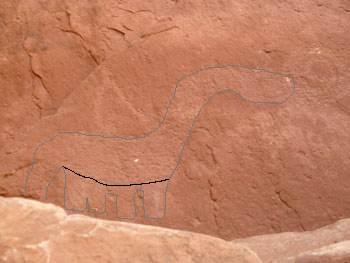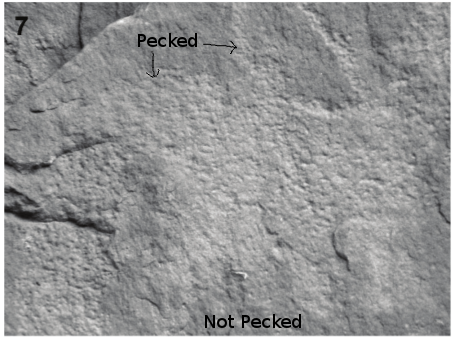In a recent post I mentioned in passing an old (ish) Brian Thomas article that he had then cited in support of some point or another. I called the article, Utah Dinosaur Petroglyph Disputed, a “hilarious fail of an article.” In clarification, it doesn’t fail at being an article – it’s got a heading and paragraphs and everything – but it’s still a general failure.
Idea is that there is a Petroglyph in Natural Bridges National Monument in Utah which looks like a sauropod dinosaur. Or so Creationists claim, as they so desperately want evidence that dinosaurs lived with humans. For a digitally enhanced picture of the petroglyph, which at least shows what we’re supposed to be seeing, see the ICR article itself.
The problem with this wonderful story is that some scientists have turned up, inspected the ‘glyph, and announced that the ‘legs’ of the ‘dinosaur’ are, in fact, mud stains, leaving us with a perfectly ordinary depiction of a snake.
The idea is that petroglyphs are made by people ‘pecking’ at the rock, but the legs do not have that pecking in them. The scientists – evolutionary biologist Phil Senter and western glyph expert Sally Cole – created the diagram to the right (taken from their paper).
Brain Thomas disputes this:
However, peck marks extend down into the presumed body of this petroglyph, even extending down into the area where front legs should be. Their sketch shows a snake or tube, but where in the actual glyph is the line for the snake’s belly, where the pecking should stop and the stains start? For that matter, perhaps the artist was depicting the creature in its natural watery habitat, which would obscure the legs. If so, then this would lend even more credibility to the sauropod interpretation of the glyph.
The last part is really wild speculation on his part. As for the first, a colleague of his has apparently taken a picture to back it up. He says:
From my picture, it is clear that the whole dinosaur shape is chipped into the rock surface, not just a mud stain. It’s pretty sad when a lowly IT guy does better science investigation than scientists.
The trouble is, his picture doesn’t make it ‘clear’. I have the not-exactly-high-quality picture below, modified to show (in grey) the outline of the supposed dinosaur and (in black) the “line for the snake’s belly, where the pecking should stop and the stains start”:
 The difference can be seen a bit more clearly in the (annotated by me) picture of the ‘glyph in the paper itself:
The difference can be seen a bit more clearly in the (annotated by me) picture of the ‘glyph in the paper itself:
 It is interesting to not that the Creationists attach no significance to the thin lines coming out of the back of the snake, nor the spirally thing in front of its head – despite both being quite obviously pecked. They see only what they want to see.
It is interesting to not that the Creationists attach no significance to the thin lines coming out of the back of the snake, nor the spirally thing in front of its head – despite both being quite obviously pecked. They see only what they want to see.
“To be fair,” Brain Thomas adds a caveat. It says:
To be fair, this particular dinosaurian representation is not the highest quality of its kind. ICR Senior Science Lecturer Frank Sherwin visited this petroglyph a number of years ago. He commented that although it looked interesting to him, he did not consider it to be as compelling as other historical evidence—such as dinosaur original soft tissues,5 written or sculpted eyewitness accounts of dragon encounters from all over the world,6 or certain Bible passages like Job 40—that have convinced him that dinosaurs and man were contemporaneous. The case for creation does not hinge on this one Utah artifact.
Yes, it is even less compelling than those things – which for the most part I have already covered – if that’s even possible. I agree completely, just not in the same way…
And then he goes on to claim that they’re biases, as if he’s not (and it was even relevant):
Those who claim to have “debunked” evidence of man and dinosaur coexistence have an admitted staunch evolutionary bias. Senter and Cole put it this way:
The findings of mainstream geology have firmly established that non-avian dinosaurs became extinct 65 million years ago when the Mesozoic Era gave way to the Cenozoic Era, and that Homo sapiens appeared less than one million years ago.4
But this statement is inaccurate. Mainstream geologists did not “find” evidence in favor of this view but have merely accommodated evidence into the pre-existing evolutionary scheme. For example, the very technique used to “determine” the age of a particular dinosaur fossil is circular. They first see whether it is a dinosaur fossil. If so, then the fossil is assigned an age of no younger than “65 million years” because that number marks the end of the “age of dinosaurs” in textbook diagrams. But this is a bad, self-serving technique.
“Mainstream geologists” first found the evidence, constructed their ‘old earth’ view, and found more evidence that told them that the dinosaurs died out 65 million years ago. Since then, they have only found things that confirm this. And no, palaeontologists do no just “assign” fossils their age. They work it out through a variety of methods that all give the same number (at very least in order of magnitude), and, without fail, it comes out “no younger than ’65 million years'”. Why? Because that’s how old they are.
See what I meant by a fail? Sometimes I wonder why Mr Thomas is even kept on the staff – he’s really letting the team down with articles like these…

Pingback: Watch Who You’re Calling “Anti-Science” « Eye on the ICR
Pingback: A. sediba and the Laetoli Footprints « Eye on the ICR
Pingback: Dinosaurs on the Ark - Page 2 - Christian Forums
I’ve been to the site to which you’re referring and have sat next to the petroglyph. While the legs might be more faint, they were still clearly chipped out and are part of the petroglyph, not by any stretch of the imagination does it look like a snake. It is also worth mentioning that if the legs are only mud splotches, they are mud splotches that were present back in 1982 (30 years ago) when the dinosaur was documented by the archaeologists Nixon and Markus. Wish I could post a copy of it here.
It’s great that that’s what the experts say – but nothing beats seeing it for yourself.